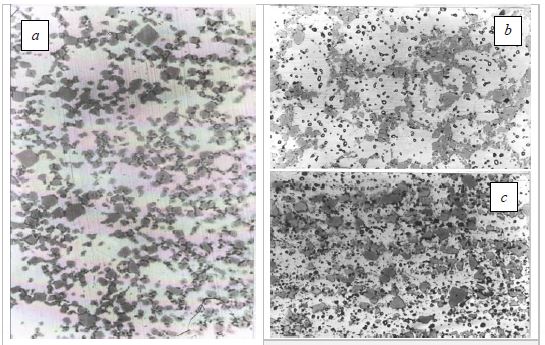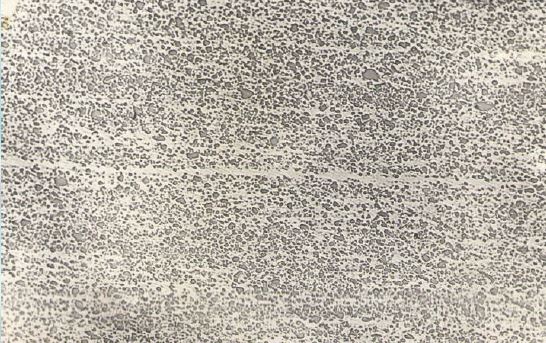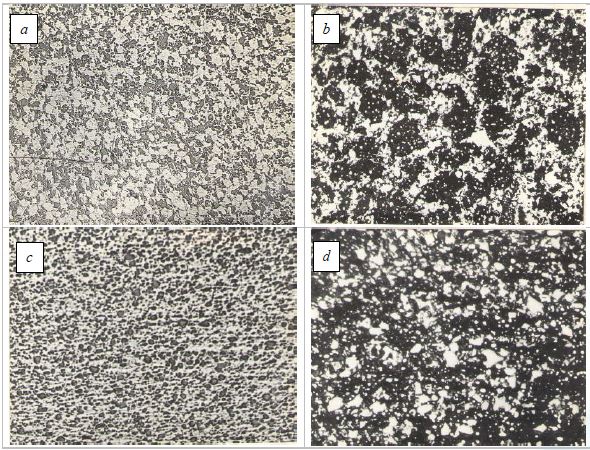CCarbidestal is a mechanically processed hard alloy that combines the properties of steels and hard alloys. Contains up to 50% of the carbide phase and, by its properties, occupies an intermediate position between steels and hard alloys.
Like steel, carbidesteel gives in to plastic deformation. The presence of heat treatable ligament allows in the annealed condition (with a hardness of HRC 38-42) to make tools of any complex shape.
The high content of the carbide phase gives the material a better wear resistance than the steels. In the hardened state, the carbidesteel hardness reaches the level of hard alloys (HRA 87-89).
The material has anti-vibration and self-lubricating properties, good resistance against sticking and coating, has a slight change in size during heat treatment, is well welded with other steels by friction and electric welding.
By changing the composition of the steel it is possible to obtain a material with special properties, working in aggressive environments, sea water, acids, dusty environments, as well as in conditions of high temperatures (up to 900 ° C).
The material has anti-vibration and self-lubricating properties, good resistance against sticking and coating, has a slight change in size during heat treatment, is well welded with other steels by friction and electric welding.
By changing the composition of the steel it is possible to obtain a material with special properties, working in aggressive environments, sea water, acids, dusty environments, as well as in conditions of high temperatures (up to 900 ° C).
The proposed technology can be considered as the possibility of obtaining new materials by the method of mechanical alloying of steel with the addition of refractory compounds (carbides, nitrides, borides, etc.).
The material developed and offered for production contains 29.2% by volume of titanium carbides (20% by weight) evenly distributed in a steel bundle of high-speed or die steel.
The main advantage of developed technology in comparison with analogues is that the steel binder retains its own carbides (primary and secondary), which provides the material with high heat resistance (red resistance) and allows the use of this carbidesteel for the sharp-cutting tool (Fig. 1).
Figure 1 – Structure of carbidesteel, hardening + tempering. (etching in Murakami reagent) .1000х а – known technology, b, c – developed technology b-sintered carbidesteel, c-deformed carbidesteel. Dark inclusions on a light background are the own carbides of the steel bond (b, c).
The following difference lies in the fact that this technology has developed plastic deformation modes for carbidesteel with a degree of deformation of more than 90%. This allows, firstly, to obtain a material in which the particles of titanium carbide are most evenly distributed in the steel bundle (Fig. 2). Secondly, due to the deformation limit, it is possible to obtain blanks that are closest in shape to the final dimensions of the finished product. Thirdly: plastic deformation significantly increases the strength properties of the material, and the mechanical properties of the developed carbidesteel KST-1D are at the level of high-alloyed high-speed steels, while the carbidesteel contains up to 50% of the carbide phase.
Figure 2 – The structure of deformed carbidesteel, 200x
Developed 4 brand (composition) carbidesteel. Two marks – in a variant sintered, and two marks in a variant deformed. The chemical composition of the developed carbidesteels is given in table 1.
Tab. 1. The chemical composition of carbidesteel
The mechanical properties of sintered and deformed carbidesteel are shown in Table 2.
Table 2. Main properties of “Carbidesteel”
The structure of standard carbidesteel is shown in Fig.3.
Picture 3 – Structure of standard carbidesteel. Before etching (500х) and after etching (800х)a,b – KCT-1C; c,d – KCT-1D.
Sintered carbidesteel is produced in the form of billets of circular cross section with a diameter of 50 to 150 mm and a height of up to 300 mm. Deformed carbidesteel is produced in billets of circular cross section (diameter from 25 to 50 mm), square (side of square from 20 to 45 mm), and rectangular cross section (strip) with thickness from 2 to 20 mm and width from 30 to 60 mm. It is possible to manufacture bimetallic billets with the bimetal in the center or outside of the billets.
Advantages of carbidesteel compared to tool steels:
– higher hardness in a cold state (by 2-4 HRC units);
– higher hardness in the hot state (heat resistance) (by 10-12 HRC units at 650 ° С);
– resists coating and sticking when processing non-ferrous metals;
– slight change in size during heat treatment;
– lighter than steel by 12%;
– higher wear resistance (2-10 times).
The advantages of carbidesteel compared to hard alloys:
– higher strength (30-50%);
– higher toughness (2-4 times);
– lower coefficient of friction (by 15-25%);
-has effect of self-lubricity;
– the ability to manufacture tools of any complex shape;
– lighter than hard alloys by 50%;
– the ability to manufacture bimetallic tools.
Advantages of carbidesteel compared to foreign analogues:
– higher microhardness and heat resistance of steel bond, achieved due to the features of the technology;
– the possibility of using carbidesteel, including for cutting tools;
– higher strength and toughness.
Work moment - discussion of the results of the experiment.




